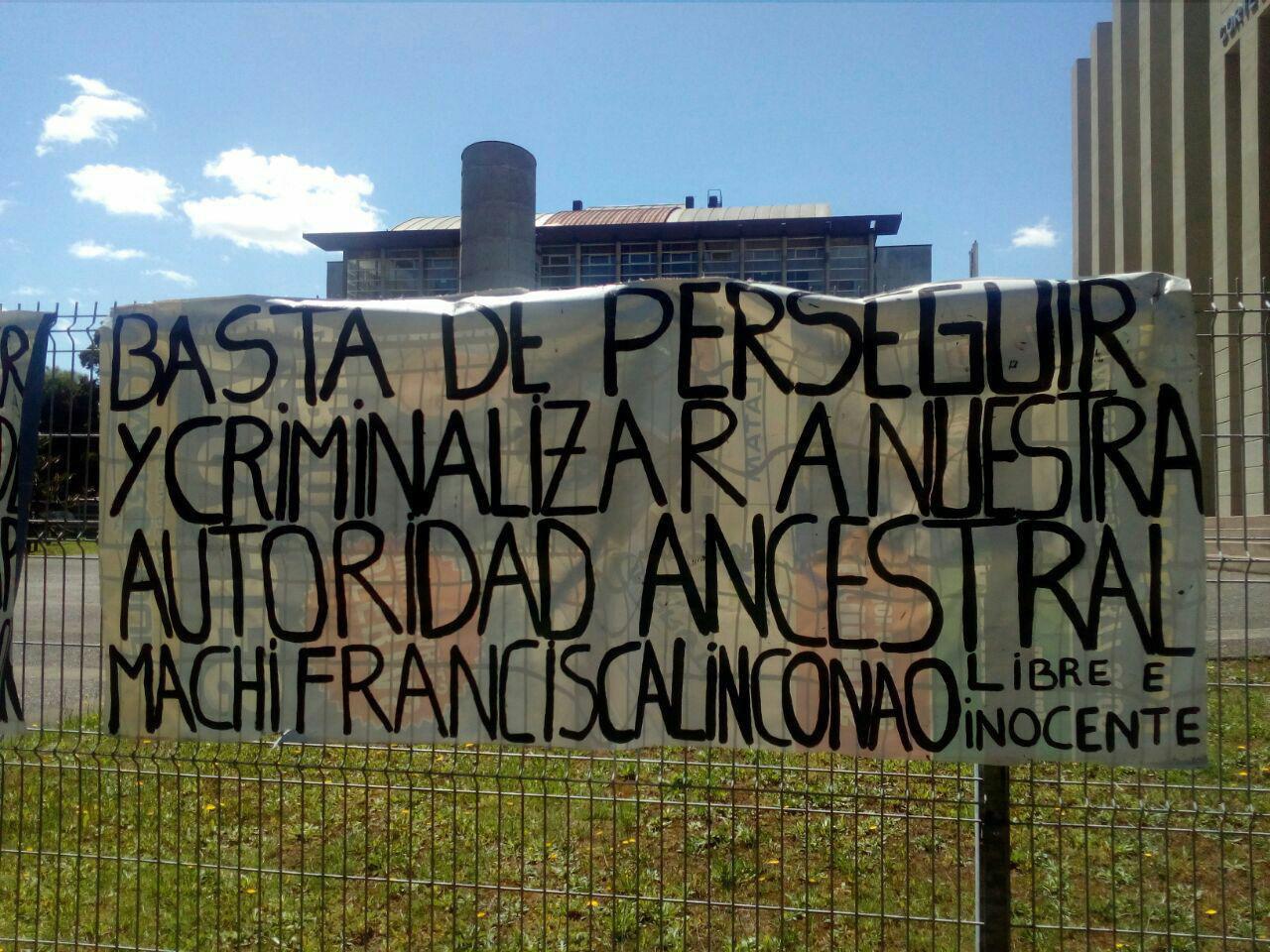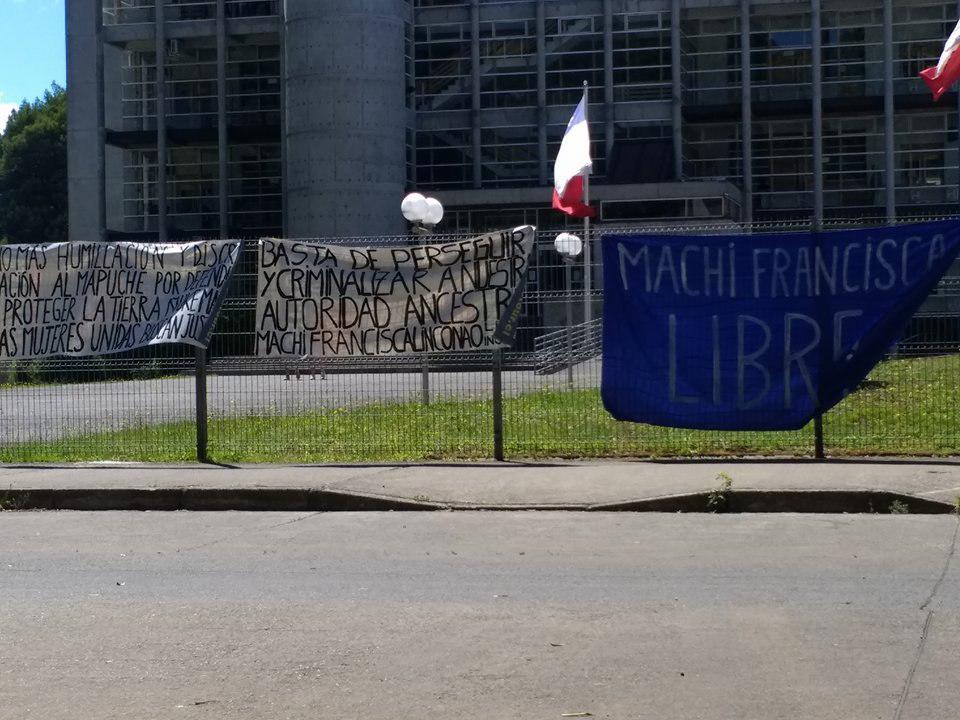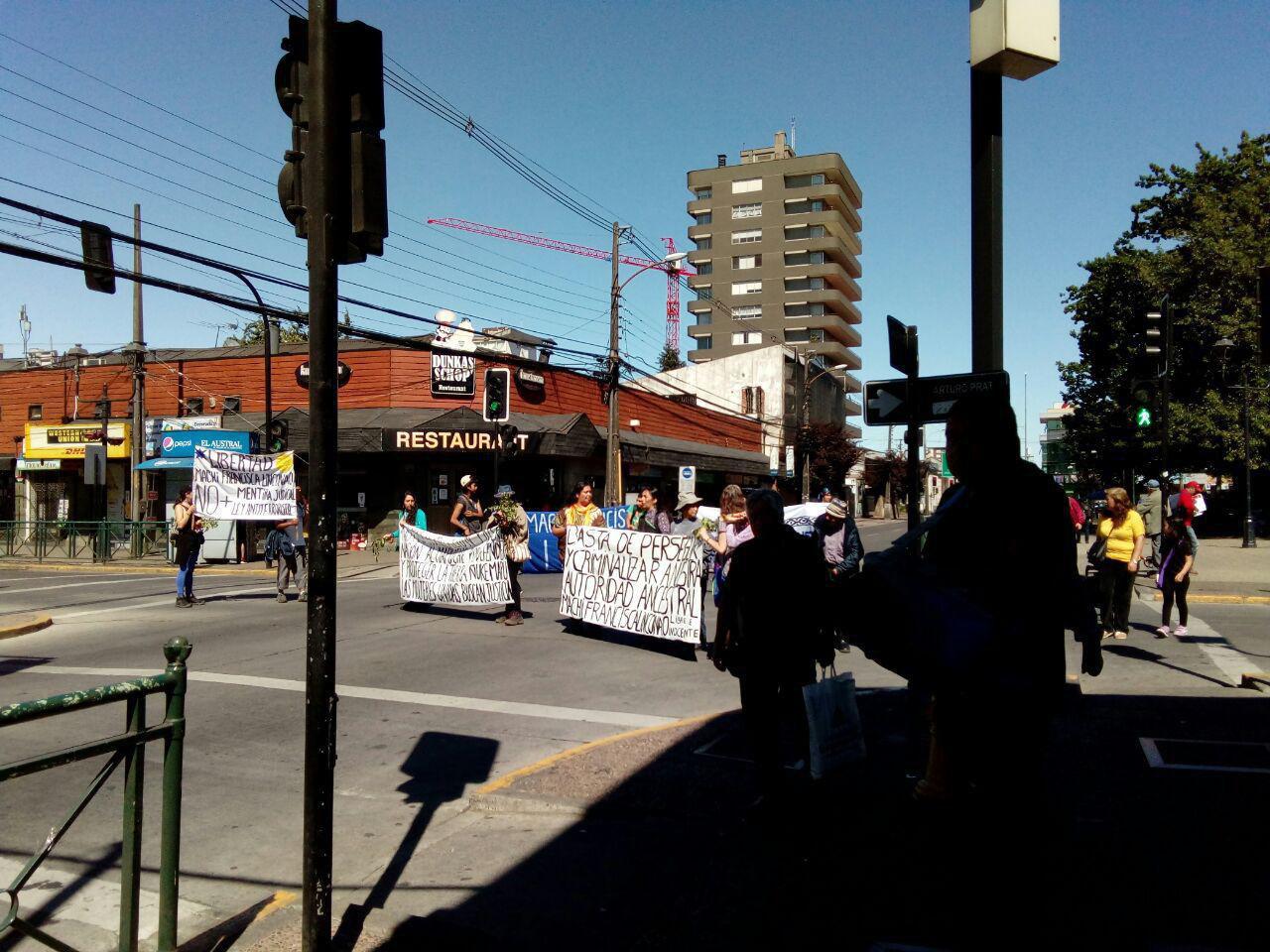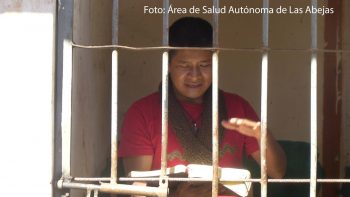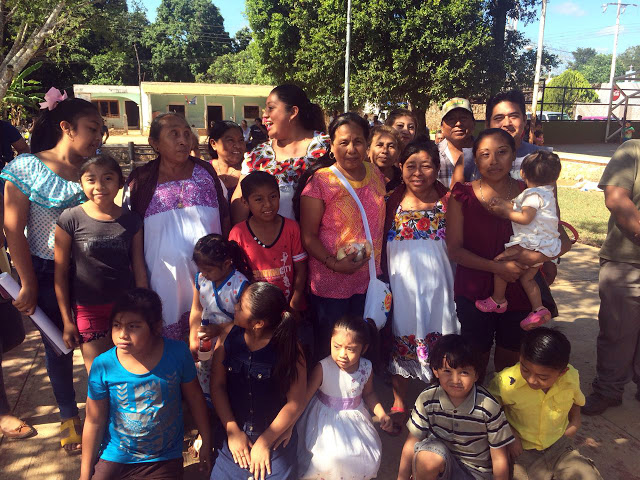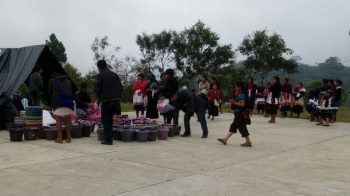Palabras de María de Jesús Patricio Martínez en Suctuc, Campeche, 22 de diciembre de 2017:
Buenas, de esta comunidad Suctuc, espero haberlo pronunciado bien.
Primero agradecerles de parte del Concejo Indígena de Gobierno el que estén aquí ustedes escuchando la palabra de este Concejo, esa palabra que nos han encomendado nuestros pueblos indígenas que han caminado por más de 20 años, que hemos caminado juntos y que hoy surge esta propuesta de participar en este proceso electoral, pero no para llegar y estar allá como los que están ahorita, solamente decidiendo por nosotros, imponiendo proyectos de muerte en nuestras comunidades, reprimiendo a las organizaciones cuando las comunidades intentan organizarse y que no están de acuerdo con lo que les imponen.
Todos estos problemas hicieron que nosotros en ese espacio que es el Congreso Nacional Indígena se tomara la decisión de participar, de participar en este proceso y llevar a las diferentes comunidades indígenas de México que tenemos que organizarnos.
Nuestra propuesta pues es organizativa, ¿por qué organizativa, hermanos? Porque es la única forma que nosotros hemos platicado, hemos analizado y hemos pensado juntos, que es la que nos va a lograr que podamos defender nuestras comunidades, solamente organizándonos desde donde estamos, desde nuestras comunidades, a sus modos, a sus tiempos, a sus formas que llevan desde que nuestros antepasados estuvieron o han estado en estas comunidades. Entonces pues, nuestra invitación es que tenemos que organizarnos desde abajo, ¿para qué? Para que ese poder vuelva al pueblo, el poder surja desde abajo, no que vengan desde arriba y nos impongan formas diferentes a nuestras comunidades, formas diferentes de vida, formas diferentes de organizarnos, tienen que surgir nuestras formas propias de nuestras comunidades, tenemos que reforzar esas estructuras que nos heredaron nuestros antepasados para cuidar nuestras tierras y territorios, tenemos que empezar desde ahí para que el poder surja de abajo, que el pueblo sea el que mande y el gobierno sea el que obedezca, pero solamente lo podemos lograr si logramos afianzarnos desde abajo.
Por eso hemos dicho: nuestra lucha no es de aquí nada más al 2018, nuestra lucha es después del 2018 que es cuando se va a venir con más fuerza todo ese proceso de destrucción de nuestros territorios. ¿Cómo los quieren destruir? Llevando a cabo proyectos ajenos a nuestras comunidades, y estos proyectos que imponen a nuestras comunidades vienen a destruir nuestros recursos naturales, vienen a contaminar nuestras aguas, vienen a despojarnos de nuestras riquezas y vienen a traernos contaminación y muerte para nuestras comunidades; y por eso los pueblos indígenas que hemos caminado en el Congreso Nacional Indígena, dijimos que no estábamos de acuerdo en que nuestras comunidades se pierdan y queremos reforzar esas comunidades, y lo estamos caminando en las diferentes regiones de este país, visitando nuestros hermanos indígenas y hoy vinimos con ustedes a traerles esa palabra, lo que estamos pensando, lo que estamos viendo que está mal y que no estamos de acuerdo.
Entonces, hermanos, en nuestras comunidades se tiene que reforzar la organización desde dentro y las comunidades tienen que decidir qué se hace y qué no se hace, porque antes de que llegaran las estructuras que se tienen, tanto municipales, estatales y federales, estaban las comunidades, y las comunidades tenían su propia organización, su propia forma de toma de acuerdos. Hay que reforzar eso, hermanos, eso es lo que va a dar vida a nuestras comunidades, hay que reforzar la salud de nuestras comunidades; nuestros abuelos se curaban con lo que daba alrededor, las plantas, los animales, las aguas, era una forma de curarse, y ahora cada vez hay más enfermos, pareciera como que ya no nos alcanzamos. Entonces qué está pasando, pues que está habiendo una contaminación y un deterioro de esos árboles, esas plantas, esas aguas, todo eso que es lo que da vida a una comunidad; entonces, por eso, nosotros nuestra palabra a donde vamos caminando, donde vamos recorriendo, es que estamos nosotros de acuerdo en que haya vida en nuestras comunidades y solamente la vida la vamos a lograr si destruimos lo que le da muerte, pero solamente lo podemos hacer organizados.
Tenemos que pensar juntos cómo le vamos a hacer para fortalecernos desde abajo de nuestras comunidades y juntos tomar el control de nuestra región, de nuestras comunidades, de nuestros barrios, de nuestras colonias, con hermanos que están en la ciudad y que también han venido luchando y que están de acuerdo con nuestra propuesta, porque esta propuesta pues es una propuesta desde los pueblos indígenas pero es una propuesta para todo México porque creemos que a todos nos está afectando por igual. El día que nuestras comunidades pierdan sus tierras, pierdan sus aguas, sus árboles, se va a morir la tierra y nos vamos a morir junto con ella.
Entonces, dijimos que vamos a luchar, tenemos que organizarnos, tenemos que caminar juntos los pueblos, tenemos que dar nuestra palabra, tenemos que hacer escuchar esa voz. Tenemos que decir que no estamos de acuerdo con todos los proyectos, proyectos que nos están imponiendo desde arriba y que lo que hemos visto es solamente destrucción en nuestras comunidades, muerte, lo que está pasando pues a nuestros alrededores. Es lo que estamos pues nosotros sintiendo los pueblos que hemos caminado en el Congreso Nacional Indígena, y es la palabra que nos han mandatado traer, es la propuesta que traemos, por eso decidimos participar en este proceso electoral para que volteen a ver a las comunidades indígenas y que se vea que las comunidades tienen problemas, y esos problemas están haciendo que nuestras comunidades mueran, desaparezcan.
Entonces no tenemos que desaparecer, hermanos, tenemos que organizarnos y levantar la voz, y decir que estamos vivos y que vamos a organizarnos porque queremos seguir existiendo, y queremos seguir conservando nuestra tierra, nuestro territorio, nuestras aguas, nuestros animales, nuestra organización propia que tenemos y que nuestros abuelos que se murieron peleando porque la tierra se siguiera conservando en nuestras comunidades, se sientan orgullosos cuando surja esa organización desde abajo.
Solamente así va a ser posible que haya un cambio, no lo busquemos arriba porque arriba no les interesa, no les interesamos como comunidades, a ellos les interesa que nosotros no estemos en nuestras comunidades, que nos vayamos fuera y les dejemos esas tierras que estamos viendo; entonces, por eso nuestra propuesta tiene que ser una fuerza que surja desde abajo, entre todos, dándonos la mano, que no nos estemos peleando entre nosotros porque los de arriba se ríen cuando nosotros nos peleamos, es lo que quieren ver ellos, que entre nosotros nos acabemos, que nos peleemos y entonces ya meten la represión y ya nos van acabando; no les demos gusto, busquemos la organización desde abajo, pongámonos de acuerdo y caminemos juntos por el bien de nuestras comunidades para que sigan viviendo, sigan existiendo y se sigan dando la mano para que todos tengamos un México diferente desde abajo, hermanos.
Esa es nuestra propuesta, esa palabra se la dejamos en su corazón, analícenla, piénsenla, y si están de acuerdo los invitamos a caminar juntos fortaleciendo ustedes sus comunidades desde acá.
Entonces muchas gracias hermanos.
Palabras de María de Jesús Patricio Martínez en Chablekal, Yucatán. 20 de diciembre 2017:
Hermanos, hermanas, compañeros, compañeras y medios que nos acompañan, gracias para que sea posible que se escuchen estas voces de este territorio.
Ya los concejales, concejalas me antecedieron en la palabra y les hacían saber que esta propuesta es una propuesta diferente a la que estamos acostumbrados que nos presentan los partidos. Es una propuesta diferente, es una propuesta en la que no aspiramos el poder, queremos crear el poder de abajo, el poder que por años se les ha arrebatado a nuestros pueblos; en este poder que está estructurado de diferente manera, donde están excluidos todos los que estamos abajo. Por eso pensamos que es diferente esta propuesta y por eso decimos que no es electoral, porque no pensamos que esto es nada más de aquí al 2018, pensamos que es para después del 2018.
Entonces nuestra propuesta surge de estos pueblos indígenas que han caminado por mas de 20 años en el Congreso Nacional Indígena, un espacio que se creó, que se pensó y que se juntaron esas voces y dijeron que si teníamos los mismos problemas y que éramos de diferentes regiones, y que éramos de diferentes pueblos, y que teníamos cada quien nuestras propias formas de organizarnos, que no era bueno estar separados; que era bueno encontrar un camino donde juntos reflexionáramos, juntos pensáramos cómo organizarnos para protegernos ante tanto despojo.
Y ahora que cumplimos esos 20 años, otra vez volvimos a reflexionar, otra vez se volvió a pensar y se vio que la situación del país estaba peor, que la situación de nuestros pueblos indígenas estaba peor porque había mucho despojo de nuestras tierras. Muchos proyectos que, en lugar de venir a beneficiar, venían a perjudicar a nuestras comunidades; venían a despojarnos de esas riquezas y aunque había intentos organizativos, lo que encontraban nuestros pueblos era represión, muerte, encarcelamiento, desaparecidos. Entonces dijimos: pues no es bueno lo que hemos caminado, no ha servido de mucho, tenemos que pensar otra forma. Tenemos que pensar de qué manera hacemos visibles todos estos problemas que están pasando nuestros pueblos, todos estos problemas que se están generando por esos proyectos capitalistas que en lugar de fortalecer, vienen a envenenar nuestras tierras, a contaminar nuestras aguas, a destruir nuestros bosques, a robarnos esas riquezas que se tienen en nuestros territorios.
Por eso se pensó que era importante dar un paso mas allá de los acostumbrados, de tener sólo los congresos y sacar una simple declaración o un pronunciamiento. Se dijo: vamos a participar en este proceso, pero vamos a participar con un Concejo Indígena de Gobierno, un Concejo Indígena de Gobierno que estaría representado por diferentes hermanos indígenas de varios pueblos, de los pueblos de México, los que han caminado en el Congreso Nacional Indígena. Y entonces se conforma pues el Concejo Indígena de Gobierno, donde participan hombres y mujeres. Entonces se dice: en esta conformación del Concejo Indígena de Gobierno tenemos que participar hombres y mujeres, porque no pueden solamente participar hombres; tenemos que participar también las mujeres para que realmente esta reconstrucción de este México desde abajo tenga esa fortaleza, tenga ese caminar de todos, esa presencia de todos que es muy importante.
Entonces por eso nuestra propuesta es diferente a los partidos, es diferente a lo que se tiene diseñado. ¿Por qué no pensar en algo diferente? ¿Por qué no pensar en algo a la inversa, donde el pueblo sea el que mande y el gobierno sea el que obedezca? Pero solamente esto va a ser posible a medida que vayamos organizándonos en nuestras comunidades, en nuestros barrios, en nuestras colonias, en nuestras regiones, en todo el país, por eso nuestra lucha no es de aquí nada más al 2018, es mucho más allá.
Tenemos que reconstruirnos, reconstituir nuestros pueblos. Yo he escuchado pues aquí, escuchado pues, dicen que la tierra la están vendiendo; y decían por ahí en una región donde pasábamos “vendemos la tierra y nos dan dinero, pero no vamos a comer ese dinero, vamos a comer lo que produce la tierra y la tierra es la que nos va a dar vida”. Es la tierra la que nos protege y es la tierra la que nos abraza cuando morimos, y si nos despojamos de la tierra, pues esta faltando lo principal para nuestra existencia.
Entonces quiero decirles a los jóvenes que ahí está nuestro trabajo, tenemos que hacer entender a nuestros padres que si nos despojamos de esa tierra, nos estamos despojando de la vida porque es algo que nos va a dar vida para después. Y la tierra, el día que se termine nos vamos a acabar junto con ella, por eso es muy importante que en este caminar que vamos dando se escuchen las diferentes formas de lucha que tienen en todos los lugares, en todos los pueblos, en todas las comunidades, y los habitantes ven con tristeza que estos proyectos que vienen de fuera, megaproyectos, lo que han traído es destrucción de esa tierra, es contaminación.
¿Entonces qué vamos a hacer? Es reforzar nuestras estructuras organizativas desde nuestras comunidades, ésa es la propuesta, que tenemos que reconstruirnos desde cada lugar donde estamos las comunidades indígenas, desde comunidad, en los barrios, colonias, ciudades, tenemos que pensar cómo se va a reconstruir las diferentes formas de vida que se tienen ahí como trabajadores, como estudiantes, como mujeres, de todos pues. Tenemos que reconstruir este país que se está resquebrajando.
Tenemos que pensar juntos cómo vamos a hacer para fortalecernos en nuestras regiones, cada quien a sus modos, sus tiempos, sus formas que vayan diseñando en cada lugar. No traemos algo ya diseñado y decirles “miren, así va a ser”; cada región lo va a hacer a sus formas, porque conocen más su región ustedes, saben aquí cómo ha sido su forma de vida. Entonces la palabra que estamos llevando a los lugares, que es la palabra que nos han mandatado los pueblos llevar, es que estamos pensando que si no nos organizamos nosotros desde los lugares donde estamos para defendernos, nadie más lo va a hacer.
Y está visto que desde arriba no va a venir ese cambio, no va a venir de arriba, se tiene que generar de abajo. Esa estructura se tiene que organizar, consolidar desde abajo y tiene que ir quedando, y tenemos que ir caminando y llevando a nuestros niños, a nuestros jóvenes, mujeres, hombres, todos juntos caminando en esta reconstrucción. Por eso decimos “nosotros no traemos a regalarles nada porque nuestra propuesta es diferente, mas bien traemos trabajo”, y esa es la invitación, una invitación a que reconstruyamos este país que lo ha destruido este sistema capitalista, y que dentro de esas ruinas saquemos esas fuerzas y esas esperanzas y esas rebeldías para reconstruir algo nuevo en beneficio de los que vienen atrás. ¿Y quién nos va a dar la fuerza? La tierra, todo lo que tenemos a nuestro alrededor.
Decían por ahí en una comunidad, que a los pueblos indígenas nos han cortado esas ramas, esos troncos; entonces la invitación es a hacer retoñar esos troncos, hacer crecer esas ramas y que crezcan fuertes y que den flor y que den fruto. ¿Y cuál va a ser esa flor y esos frutos? La misma que nosotros vayamos generando desde la misma organización a la que estamos invitando los pueblos. Es la única esperanza, hermanos, no va a haber otra, y no la esperemos de arriba, de los que están en el poder.
Por eso pensamos que no queremos llegar arriba porque es un sistema capitalista que es lo que está moviendo, que ellos ya saben a quien van a poner, ellos ya saben cuál es el que sigue. Solamente nos usan y se acuerdan de nosotros cada 6 años, y pasa el tiempo y alguien decía “quedamos igual”, y yo digo que quedamos peor pues, porque son ellos los que se están enriqueciendo, son ellos los que están modificando todas estas leyes a sus modos para ellos asegurar ese despojo. ¿y que nos queda a los pueblos? Organizarnos.
Organizarnos para que ya no se sigan acabando nuestras comunidades, ya no nos sigan imponiendo desde fuera formas diferentes a las que tenemos. Hay que reforzar las que tenemos, hay que ponernos a platicar cómo le vamos a hacer para sobrevivir, y lo han demostrado los pueblos, ahí están presentes los pueblos. Si nos dicen que no estamos, que no somos indígenas, hay que demostrar que sí. Hay que consolidar esa lengua, esa forma de organización, ese vestido, todas esas formas de vida que tenemos en nuestras comunidades. Y en la ciudad hay que consolidar esa organización para juntos defendernos, juntos ponernos de acuerdo cómo vamos a consolidar ese México de abajo y solamente organizados es como vamos a estar para después, porque no pensamos que esto es nada más al 2018, sino después del 2018, es como tenemos que salir fuertes, es como tenemos que organizarnos.
Entonces, hermanos, por eso nuestra propuesta es una propuesta de abajo, es una propuesta a la inversa, porque es de abajo donde va surgir ese poder. Entonces, de mi parte les agradezco que escuchen nuestra palabra, se las dejamos en su corazón, ustedes sabrán, ustedes nos dirán si tenemos la razón, y si así es, los invitamos a caminar juntos desde el lugar donde están.
Gracias hermanos.

